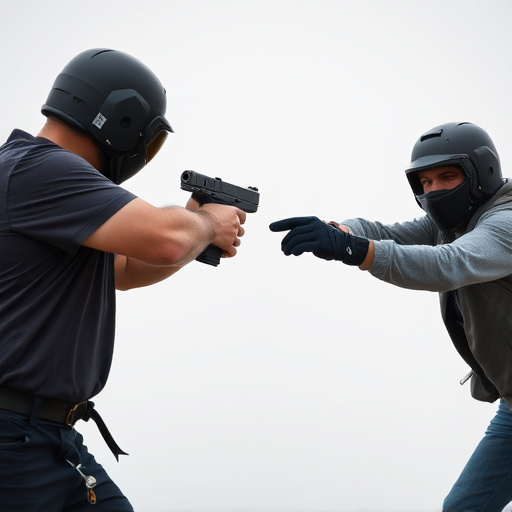Stun guns, or Electronic Control Devices (ECDs), use high-voltage pulses to temporarily incapacitate assailants without severe physical harm. While they don't cause permanent nervous system damage, prolonged or repeated shocks may lead to neurological issues. Comfortable grip designs and ergonomic features reduce such side effects by fitting well in the hand, minimizing strain, and enhancing precision. Modern stun guns incorporate advanced safety mechanisms like voltage control, automatic shut-off, and smart sensors for responsible usage. These innovations balance effectiveness with user safety, making self-defense more accessible and appealing to a wider range of individuals.
In today’s world, personal safety is paramount, making stun guns a popular self-defense tool. This article delves into the design innovations behind comfortable grip stun guns, exploring their functionality and impact on the body. We dissect the neurological effects of electric shock, highlighting the complex relationship between stun gun design and user safety. By examining ergonomics, safety measures, and power considerations, we uncover the future of stun guns, focusing on balancing effectiveness with user-friendliness while addressing critical stun gun neurological side effects.
- Understanding Stun Gun Functionality and Its Impact on the Body
- Neurological Effects: The Complex Relationship with Electric Shock
- Designing for Comfort: Ergonomics in Stun Gun Creation
- Safety Measures: Mitigating Risks Through Innovative Features
- Balancing Power and User-Friendliness: The Future of Stun Guns
Understanding Stun Gun Functionality and Its Impact on the Body

Stun guns, also known as electronic control devices (ECDs), operate by delivering a strong electric shock to disrupt an individual’s muscular control and balance. When activated, the stun gun emits a high-voltage, low-current electrical pulse that interferes with the brain’s ability to send signals to the muscles, leading to temporary paralysis. This disruption is achieved without causing significant physical harm or lasting neurological side effects. Unlike traditional firearms, stun guns do not discharge projectiles, minimizing the risk of permanent injury or death.
The impact of a stun gun shock on the body is designed to be incapacitating rather than deadly. The electrical current disrupts nerve signals and causes muscle contractions, leading to loss of balance and consciousness for a brief period. This temporary paralysis allows users to gain control over an assailant until help arrives. While some concerns exist regarding potential neurological side effects, studies have shown that the shock from a stun gun does not cause permanent damage to the nervous system.
Neurological Effects: The Complex Relationship with Electric Shock

Stun guns, despite their name, deliver electric shocks that can have significant neurological effects on the target. The impact isn’t merely physical; it’s a complex interplay between electricity and the nervous system. When activated, stun guns release a high-voltage, low-current electrical pulse, which disrupts nerve signals and causes muscular paralysis. This disruption affects the brain’s ability to send and receive messages, leading to temporary disorientation, confusion, and in some cases, even loss of consciousness.
However, it’s crucial to note that while these effects can incapacitate a target swiftly, they are not fatal. The neurological side effects of stun guns are designed to be non-lethal, making them a tool for self-defense or law enforcement applications where disabling an individual is the primary goal. Nonetheless, prolonged or repeated exposure to such shocks could potentially lead to more severe and lasting neurological damage, underscoring the importance of using these devices responsibly and in accordance with safety guidelines.
Designing for Comfort: Ergonomics in Stun Gun Creation

When designing stun guns, comfort and ergonomics play a significant role in ensuring their effectiveness and user safety. A well-designed grip is essential to mitigate the potential neurological side effects associated with stun gun use, such as temporary muscle paralysis or disorientation. Comfortable grips are designed to fit snugly in the user’s hand, reducing strain during deployment and allowing for more precise control. Ergonomic features like soft, non-slip materials and a balanced weight distribution enhance user confidence and minimize the risk of accidental discharge or misplacement.
These ergonomic considerations are crucial for users from diverse demographics, including those with smaller hands or limited dexterity. By prioritizing comfort in stun gun creation, manufacturers can foster consumer trust and promote responsible use, ensuring that individuals feel empowered to protect themselves without compromising safety or effectiveness.
Safety Measures: Mitigating Risks Through Innovative Features

Safety measures are paramount when considering stun gun designs, especially as these devices carry potential risks, including neurological side effects. Innovative features have been introduced to mitigate these dangers. For instance, many modern stun guns employ advanced circuitry and control mechanisms that help prevent excessive voltage delivery, reducing the likelihood of adverse health impacts. These safety systems often include automatic shut-off mechanisms after a set stun duration, ensuring users do not accidentally prolong exposure to high voltage.
Additionally, designers have incorporated smart sensors and user-friendly interfaces to provide real-time feedback during use. This allows operators to accurately gauge their device’s performance and adjust settings accordingly, further minimizing the chances of neurological damage. Such safety measures are crucial in balancing the stun gun’s effectiveness as a self-defense tool with responsible usage, ensuring that individuals can protect themselves without endangering their health or well-being.
Balancing Power and User-Friendliness: The Future of Stun Guns

In the ongoing evolution of personal safety devices, the stun gun has seen significant advancements, particularly in addressing user-friendliness and reducing neurological side effects while maintaining effective power. Comfortable grip designs are a prime example of this balance between power and usability. Modern stun guns are now equipped with ergonomic handles and trigger mechanisms that allow users to deploy the device quickly and comfortably without compromising its electric current output. This blend of functionality and ease of use ensures individuals can defend themselves confidently in various situations, knowing they have control over their safety.
The integration of smart technology further enhances these comfortable grip stun guns, offering features like adjustable voltage settings that cater to different user needs and preferences. By mitigating the potential neurological side effects associated with traditional stun guns, these innovative designs make self-defense more accessible and appealing to a broader range of individuals. As the market continues to adapt, this harmony between power and user-friendliness promises to shape the future of personal safety devices, giving users the peace of mind they need while ensuring their well-being.
In conclusion, while stun guns offer a crucial self-defense mechanism, designing them with a comfortable grip and user-friendly features is essential. By balancing power and ease of use, manufacturers can ensure these devices are accessible to more people without compromising safety or effectiveness. Understanding the neurological side effects of electric shock and implementing innovative safety measures further enhances their responsible use. As technology evolves, focusing on ergonomics and mitigating risks will solidify stun guns as a reliable tool for personal security.
